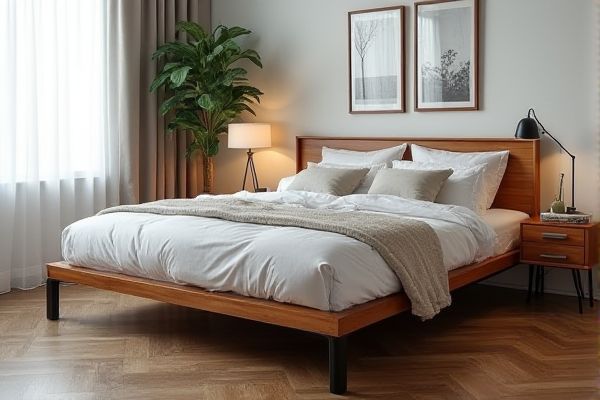
Metal bed frames offer superior durability and modern design, while wood bed frames provide warmth and traditional aesthetics with natural variations. Discover which option best suits your style and comfort needs by reading the rest of the article.
Table of Comparison
| Feature | Metal Bed Frame | Wood Bed Frame |
|---|---|---|
| Durability | High resistance to wear and tear, rust-resistant with coatings | Strong but prone to scratches, cracks, and warping over time |
| Weight | Lightweight and easy to move | Heavier and less portable |
| Design & Aesthetics | Modern, industrial look, available in various colors and finishes | Classic, warm appearance with natural wood grains |
| Maintenance | Low maintenance; occasional cleaning and checking for rust | Requires regular polishing and protection from moisture |
| Noise | Can squeak if joints loosen | Generally quieter with solid construction |
| Cost | Typically more affordable | Usually higher priced due to material and craftsmanship |
| Assembly | Simple and quick assembly | May require more tools and effort |
| Pest Resistance | Not susceptible to pests | Can be vulnerable to termites and wood-boring insects |
Introduction to Metal vs Wood Bed Frames
Metal bed frames offer superior durability and a modern aesthetic, often featuring sleek designs and resistance to pests and warping. Wood bed frames provide natural warmth and classic appeal, with variations in grain and finish that enhance bedroom decor. Your choice depends on preferences for style, maintenance, and longevity in bedroom furniture.
Material Composition and Construction
Metal bed frames feature steel or iron construction, providing high durability and resistance to wear and tear, making them ideal for long-term support and heavy mattresses. Wooden bed frames are crafted from solid hardwoods like oak, maple, or pine, offering natural strength, aesthetic warmth, and the option for intricate designs or custom finishes. Your choice depends on whether you prioritize the sleek, industrial style and sturdiness of metal or the classic, organic appeal and customizable nature of wood.
Aesthetic Appeal and Design Versatility
Metal bed frames offer sleek, modern aesthetics with minimalistic lines and an industrial feel, making them ideal for contemporary or urban bedroom designs. Wood bed frames provide rich texture and warmth, accommodating a range of styles from rustic farmhouse to classic traditional, with varied finishes like distressed, polished, or painted wood. Both materials boast design versatility but differ in visual impact--metal emphasizes durability and simplicity, while wood highlights natural beauty and timeless elegance.
Durability and Longevity
Metal bed frames typically offer superior durability and longevity due to their resistance to warping, cracking, and insect damage, common issues in wood frames. High-quality steel or iron metal frames can support heavier weights and withstand years of use without significant wear. Wood bed frames, while aesthetically pleasing, are more susceptible to environmental factors like humidity and pests, which may shorten their lifespan compared to metal alternatives.
Weight Capacity and Stability
Metal bed frames typically offer higher weight capacity and enhanced stability due to their robust steel construction, supporting up to 500-1000 pounds depending on design. Wood bed frames, while offering aesthetic warmth, generally support less weight, averaging around 300-600 pounds, and may be prone to warping or weakening over time. Choosing a metal frame is optimal for durability and heavy-duty support, whereas wood frames may require reinforcement to match the stability of metal counterparts.
Assembly and Maintenance
Metal bed frames typically offer simpler assembly with fewer parts and included tools, making setup quicker and more straightforward, while wood bed frames often require more precise alignment and additional hardware. Metal frames demand minimal maintenance, usually just occasional tightening of bolts and wiping down, whereas wood frames may need periodic polishing or treatment to prevent warping and scratches. Your choice depends on whether you prefer easy assembly and low upkeep or the classic aesthetic and care involved with wood.
Noise and Creaking Factors
Metal bed frames tend to produce more noise and creaking due to their joints and metal components rubbing together, especially over time or with movement. Wood bed frames generally offer a quieter experience, but they can creak if the wood dries out, warps, or if the joints loosen. To minimize noise in either option, ensure all bolts and screws are tightly secured and consider adding protective pads or lubricant at contact points.
Cost Comparison
Metal bed frames generally offer a more budget-friendly option, with prices typically ranging from $100 to $300 depending on design and quality. Wood bed frames, especially those made from solid hardwoods like oak or maple, tend to be more expensive, often costing between $300 and $1,000 or more. The cost difference is influenced by factors such as material durability, craftsmanship, and aesthetic appeal, with metal frames providing affordability and wood frames offering long-term value and style.
Environmental Impact and Sustainability
Metal bed frames often have a lower environmental impact due to their durability and recyclability, reducing waste over time. Wood bed frames, particularly those made from responsibly sourced or reclaimed timber, offer renewable and biodegradable benefits but may involve deforestation if not managed sustainably. Your choice should consider factors like material sourcing, lifespan, and end-of-life recyclability to support eco-friendly and sustainable home furnishings.
Choosing the Right Bed Frame for Your Needs
Metal bed frames offer durability, easy assembly, and a modern aesthetic, making them ideal for minimalist or industrial-style bedrooms. Wood bed frames provide warmth, classic design, and customizable options, suitable for traditional or rustic interiors. Selecting the right bed frame depends on factors like room decor, weight support, budget, and maintenance preferences.
 homyna.com
homyna.com